
Intel® Core™ i7-900 Desktop Processor Extreme Edition Series on 32-nm Process Datasheet, Volume 1
1 /
102Páginas
Excertos do catálogo
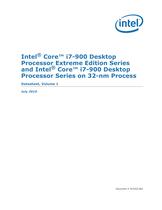
Document # 323252-002 Intel® Core™ i7-900 Desktop Processor Extreme Edition Series and Intel® Core™ i7-900 Desktop Processor Series on 32-nm Process Datasheet, Volume 1 July 2010
Abrir o catálogo na página 1
2 Datasheet INFORMATION IN THIS DOCUMENT IS PROVIDED IN CONNECTION WITH INTEL PRODUCTS. NO LICENSE, EXPRESS OR IMPLIED, BY ESTOPPEL OR OTHERWISE, TO ANY INTELLECTUAL PROPERTY RIGHTS IS GRANTED BY THIS DOCUMENT. EXCEPT AS PROVIDED IN INTEL'S TERMS AND CONDITIONS OF SALE FOR SUCH PRODUCTS, INTEL ASSUMES NO LIABILITY WHATSOEVER, AND INTEL DISCLAIMS ANY EXPRESS OR IMPLIED WARRANTY, RELATING TO SALE AND/OR USE OF INTEL PRODUCTS INCLUDING LIABILITY OR WARRANTIES RELATING TO FITNESS FOR A PARTICULAR PURPOSE, MERCHANTABILITY, OR INFRINGEMENT OF ANY PATENT, COPYRIGHT OR OTHER INTELLECTUAL PROPERTY...
Abrir o catálogo na página 2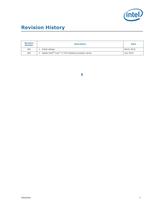
Datasheet 7 Revision History § Revision Number Description Date 001 • Initial release March 2010 002 • Added Intel® Core™ i7-970 desktop processor series July 2010
Abrir o catálogo na página 7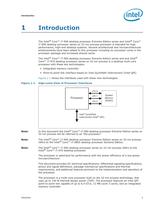
Datasheet 9 Introduction 1 Introduction The Intel® Core™ i7-900 desktop processor Extreme Edition series and Intel® Core™ i7-900 desktop processor series on 32-nm process processor is intended for high performance, high-end desktop systems. Several architectural and microarchitectural enhancements have been added to this processor including six processor cores in the processor package and increased shared cache. The Intel® Core™ i7-900 desktop processor Extreme Edition series and and Intel® Core™ i7-970 desktop processor series on 32-nm process is a desktop multi-core processor with these...
Abrir o catálogo na página 9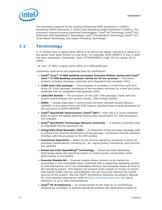
Introduction 10 Datasheet The processor supports all the existing Streaming SIMD Extensions 2 (SSE2), Streaming SIMD Extensions 3 (SSE3) and Streaming SIMD Extensions 4 (SSE4). The processor supports several Advanced Technologies: Intel® 64 Technology (Intel® 64), Enhanced Intel SpeedStep® Technology, Intel® Virtualization Technology (Intel® VT), Turbo Boost Technology, and Hyper-Threading Technology. 1.1 Terminology A ‘#’ symbol after a signal name refers to an active low signal, indicating a signal is in the active state when driven to a low level. For example, when RESET# is low, a reset...
Abrir o catálogo na página 10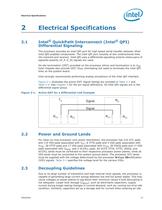
Datasheet 13 Electrical Specifications 2 Electrical Specifications 2.1 Intel® QuickPath Interconnect (Intel® QPI) Differential Signaling The processor provides an Intel QPI port for high speed serial transfer between other Intel QPI-enabled components. The Intel QPI port consists of two unidirectional links (for transmit and receive). Intel QPI uses a differential signalling scheme where pairs of opposite-polarity (D_P, D_N) signals are used. On-die termination (ODT) provided on the processor silicon and termination is to VSS. Intel chipsets also provide ODT; thus, eliminating the need to...
Abrir o catálogo na página 13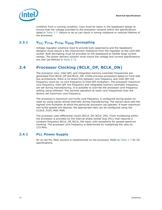
Electrical Specifications 14 Datasheet condition from a running condition. Care must be taken in the baseboard design to ensure that the voltage provided to the processor remains within the specifications listed in Table 2-7. Failure to do so can result in timing violations or reduced lifetime of the processor. 2.3.1 VCC, VTTA, VTTD, VDDQ Decoupling Voltage regulator solutions need to provide bulk capacitance and the baseboard designer must assure a low interconnect resistance from the regulator to the LGA1366 socket. Bulk decoupling must be provided on the baseboard to handle large current...
Abrir o catálogo na página 14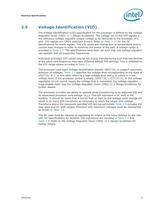
Datasheet 15 Electrical Specifications 2.5 Voltage Identification (VID) The Voltage Identification (VID) specification for the processor is defined by the Voltage Regulator Down (VRD) 11.1 Design Guidelines. The voltage set by the VID signals is the reference voltage regulator output voltage to be delivered to the processor VCC pins. VID signals are CMOS push/pull drivers. Refer to Table 2-15 for the DC specifications for these signals. The VID codes will change due to temperature and/or current load changes in order to minimize the power of the part. A voltage range is provided in Table...
Abrir o catálogo na página 15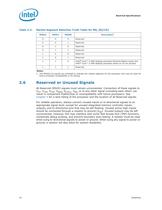
Electrical Specifications 18 Datasheet 2.6 Reserved or Unused Signals All Reserved (RSVD) signals must remain unconnected. Connection of these signals to VCC, VTTA, VTTD, VDDQ, VCCPLL, VSS, or to any other signal (including each other) can result in component malfunction or incompatibility with future processors. See Chapter 4 for a land listing of the processor and the location of all Reserved signals. For reliable operation, always connect unused inputs or bi-directional signals to an appropriate signal level, except for unused integrated memory controller inputs, outputs, and...
Abrir o catálogo na página 18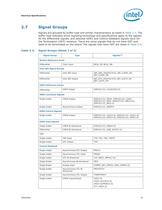
Datasheet 19 Electrical Specifications 2.7 Signal Groups Signals are grouped by buffer type and similar characteristics as listed in Table 2-3. The buffer type indicates which signaling technology and specifications apply to the signals. All the differential signals, and selected DDR3 and Control Sideband signals have On- Die Termination (ODT) resistors. There are some signals that do not have ODT and need to be terminated on the board. The signals that have ODT are listed in Table 2-4. Table 2-3. Signal Groups (Sheet 1 of 2) Signal Group Type Signals1,2 System Reference Clock Differential...
Abrir o catálogo na página 19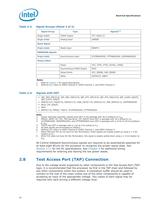
Electrical Specifications 20 Datasheet Note: 1. Unless otherwise specified, signals have ODT in the package with 50 Ă pulldown to VSS. 2. PREQ#, BPM[7:0], TDI, TMS and BCLK_ITP_D[N/P] have ODT in package with 35 Ă pullup to VTT. 3. VCCPWRGOOD, VDDPWRGOOD, and VTTPWRGOOD have ODT in package with a 10 kĂ to 20 kĂ pulldown to VSS. 4. TRST# has ODT in package with a 1 kĂ to 5 kĂ pullup to VTT. 5. All DDR signals are terminated to VDDQ/2 6. DDR{0/1/2} refers to DDR3 Channel 0, DDR3 Channel 1, and DDR3 Channel 2. 7. While TMS and TDI do not have On-Die Termination, these signals are weakly...
Abrir o catálogo na página 20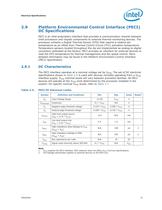
Datasheet 21 Electrical Specifications 2.9 Platform Environmental Control Interface (PECI) DC Specifications PECI is an Intel proprietary interface that provides a communication channel between Intel processors and chipset components to external thermal monitoring devices. The processor contains a Digital Thermal Sensor (DTS) that reports a relative die temperature as an offset from Thermal Control Circuit (TCC) activation temperature. Temperature sensors located throughout the die are implemented as analog-to-digital converters calibrated at the factory. PECI provides an interface for...
Abrir o catálogo na página 21Todos os catálogos e folhetos técnicos Intel
-
10th Gen Intel® Core
7 Páginas
-
10th Gen
8 Páginas
-
nuc-celeron
4 Páginas
-
Intel® Optane™ SSD DC P4800X Series
2 Páginas
-
Intel® NUC 8 Home Mini PC
4 Páginas
-
Intel® Xeon® Scalable Platform
14 Páginas
-
Intel® Ethernet Controller XL710
1726 Páginas
-
Intel® Xeon® Processor E3-1200 v5
130 Páginas
-
Intel® Quark™ SoC X1000 Series
934 Páginas
-
Intel® X99 Chipset
4 Páginas
-
Mini PC - Intel® NUC Kit DC3217IYE
4 Páginas
-
Mini PC?Intel® NUC Kit NUC5i5RYH
4 Páginas
-
Intel® Desktop Board DQ67EP
4 Páginas
-
Intel® Ethernet Switch FM4000
270 Páginas
-
Intel® NUC Board DE3815TYBE
82 Páginas
-
S2600GZ and S2600GL
245 Páginas
-
Intel® Solid-State Drive DC P3700 Series
42 Páginas
-
i7-lga2011
314 Páginas
-
c600-series
936 Páginas
-
b75-express
4 Páginas
-
desktop-board
4 Páginas
-
3rd-gen-core-desktops
2 Páginas
-
/3rd-gen-core
2 Páginas
Catálogos arquivados
-
Intel® Server System SR2600UR
8 Páginas
-
Intel® Ethernet Controllers
2 Páginas
-
Intel® 3450 Chipset
2 Páginas
-
Intel® 3000 and 3010 Chipset
4 Páginas
-
Intel® X58 Express Chipset
4 Páginas
-
Intel® Server Board S1200BT
8 Páginas
-
Intel® Desktop Board DX58SO2
4 Páginas
-
Intel® Xeon® Processor 5000 Series Datasheet
104 Páginas
-
Intel® I/O Processor Overview
4 Páginas































































